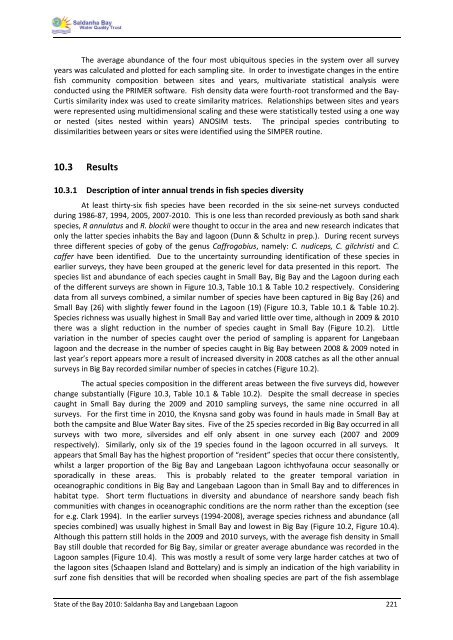State of the Bay Report 2010-Final - Anchor Environmental
State of the Bay Report 2010-Final - Anchor Environmental
State of the Bay Report 2010-Final - Anchor Environmental
You also want an ePaper? Increase the reach of your titles
YUMPU automatically turns print PDFs into web optimized ePapers that Google loves.
The average abundance <strong>of</strong> <strong>the</strong> four most ubiquitous species in <strong>the</strong> system over all survey<br />
years was calculated and plotted for each sampling site. In order to investigate changes in <strong>the</strong> entire<br />
fish community composition between sites and years, multivariate statistical analysis were<br />
conducted using <strong>the</strong> PRIMER s<strong>of</strong>tware. Fish density data were fourth-root transformed and <strong>the</strong> <strong>Bay</strong>-<br />
Curtis similarity index was used to create similarity matrices. Relationships between sites and years<br />
were represented using multidimensional scaling and <strong>the</strong>se were statistically tested using a one way<br />
or nested (sites nested within years) ANOSIM tests. The principal species contributing to<br />
dissimilarities between years or sites were identified using <strong>the</strong> SIMPER routine.<br />
10.3 Results<br />
10.3.1 Description <strong>of</strong> inter annual trends in fish species diversity<br />
At least thirty-six fish species have been recorded in <strong>the</strong> six seine-net surveys conducted<br />
during 1986-87, 1994, 2005, 2007-<strong>2010</strong>. This is one less than recorded previously as both sand shark<br />
species, R annulatus and R. blockii were thought to occur in <strong>the</strong> area and new research indicates that<br />
only <strong>the</strong> latter species inhabits <strong>the</strong> <strong>Bay</strong> and lagoon (Dunn & Schultz in prep.). During recent surveys<br />
three different species <strong>of</strong> goby <strong>of</strong> <strong>the</strong> genus Caffrogobius, namely: C. nudiceps, C. gilchristi and C.<br />
caffer have been identified. Due to <strong>the</strong> uncertainty surrounding identification <strong>of</strong> <strong>the</strong>se species in<br />
earlier surveys, <strong>the</strong>y have been grouped at <strong>the</strong> generic level for data presented in this report. The<br />
species list and abundance <strong>of</strong> each species caught in Small <strong>Bay</strong>, Big <strong>Bay</strong> and <strong>the</strong> Lagoon during each<br />
<strong>of</strong> <strong>the</strong> different surveys are shown in Figure 10.3, Table 10.1 & Table 10.2 respectively. Considering<br />
data from all surveys combined, a similar number <strong>of</strong> species have been captured in Big <strong>Bay</strong> (26) and<br />
Small <strong>Bay</strong> (26) with slightly fewer found in <strong>the</strong> Lagoon (19) (Figure 10.3, Table 10.1 & Table 10.2).<br />
Species richness was usually highest in Small <strong>Bay</strong> and varied little over time, although in 2009 & <strong>2010</strong><br />
<strong>the</strong>re was a slight reduction in <strong>the</strong> number <strong>of</strong> species caught in Small <strong>Bay</strong> (Figure 10.2). Little<br />
variation in <strong>the</strong> number <strong>of</strong> species caught over <strong>the</strong> period <strong>of</strong> sampling is apparent for Langebaan<br />
lagoon and <strong>the</strong> decrease in <strong>the</strong> number <strong>of</strong> species caught in Big <strong>Bay</strong> between 2008 & 2009 noted in<br />
last year’s report appears more a result <strong>of</strong> increased diversity in 2008 catches as all <strong>the</strong> o<strong>the</strong>r annual<br />
surveys in Big <strong>Bay</strong> recorded similar number <strong>of</strong> species in catches (Figure 10.2).<br />
The actual species composition in <strong>the</strong> different areas between <strong>the</strong> five surveys did, however<br />
change substantially (Figure 10.3, Table 10.1 & Table 10.2). Despite <strong>the</strong> small decrease in species<br />
caught in Small <strong>Bay</strong> during <strong>the</strong> 2009 and <strong>2010</strong> sampling surveys, <strong>the</strong> same nine occurred in all<br />
surveys. For <strong>the</strong> first time in <strong>2010</strong>, <strong>the</strong> Knysna sand goby was found in hauls made in Small <strong>Bay</strong> at<br />
both <strong>the</strong> campsite and Blue Water <strong>Bay</strong> sites. Five <strong>of</strong> <strong>the</strong> 25 species recorded in Big <strong>Bay</strong> occurred in all<br />
surveys with two more, silversides and elf only absent in one survey each (2007 and 2009<br />
respectively). Similarly, only six <strong>of</strong> <strong>the</strong> 19 species found in <strong>the</strong> lagoon occurred in all surveys. It<br />
appears that Small <strong>Bay</strong> has <strong>the</strong> highest proportion <strong>of</strong> “resident” species that occur <strong>the</strong>re consistently,<br />
whilst a larger proportion <strong>of</strong> <strong>the</strong> Big <strong>Bay</strong> and Langebaan Lagoon ichthy<strong>of</strong>auna occur seasonally or<br />
sporadically in <strong>the</strong>se areas. This is probably related to <strong>the</strong> greater temporal variation in<br />
oceanographic conditions in Big <strong>Bay</strong> and Langebaan Lagoon than in Small <strong>Bay</strong> and to differences in<br />
habitat type. Short term fluctuations in diversity and abundance <strong>of</strong> nearshore sandy beach fish<br />
communities with changes in oceanographic conditions are <strong>the</strong> norm ra<strong>the</strong>r than <strong>the</strong> exception (see<br />
for e.g. Clark 1994). In <strong>the</strong> earlier surveys (1994-2008), average species richness and abundance (all<br />
species combined) was usually highest in Small <strong>Bay</strong> and lowest in Big <strong>Bay</strong> (Figure 10.2, Figure 10.4).<br />
Although this pattern still holds in <strong>the</strong> 2009 and <strong>2010</strong> surveys, with <strong>the</strong> average fish density in Small<br />
<strong>Bay</strong> still double that recorded for Big <strong>Bay</strong>, similar or greater average abundance was recorded in <strong>the</strong><br />
Lagoon samples (Figure 10.4). This was mostly a result <strong>of</strong> some very large harder catches at two <strong>of</strong><br />
<strong>the</strong> lagoon sites (Schaapen Island and Bottelary) and is simply an indication <strong>of</strong> <strong>the</strong> high variability in<br />
surf zone fish densities that will be recorded when shoaling species are part <strong>of</strong> <strong>the</strong> fish assemblage<br />
<strong>State</strong> <strong>of</strong> <strong>the</strong> <strong>Bay</strong> <strong>2010</strong>: Saldanha <strong>Bay</strong> and Langebaan Lagoon 221

















